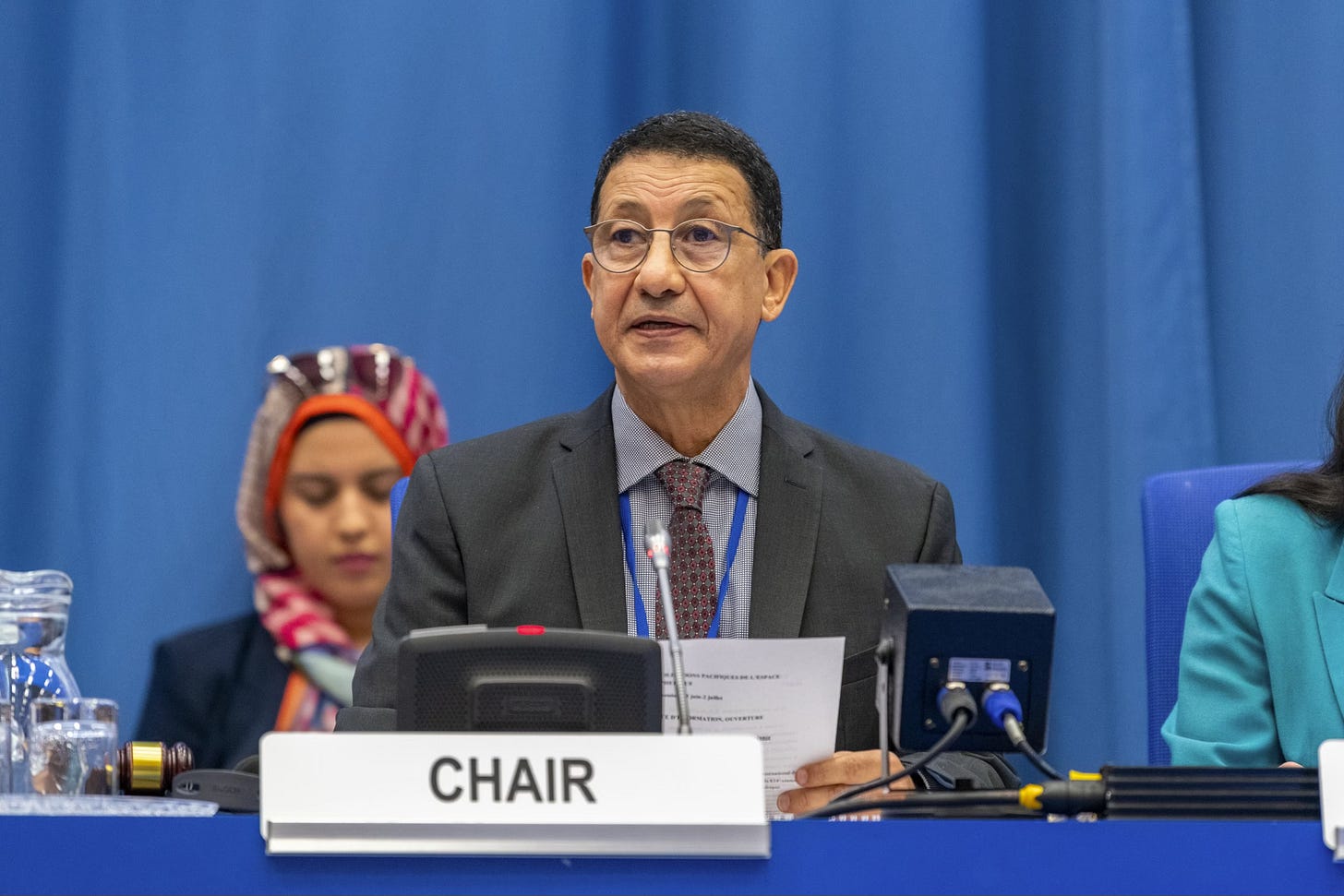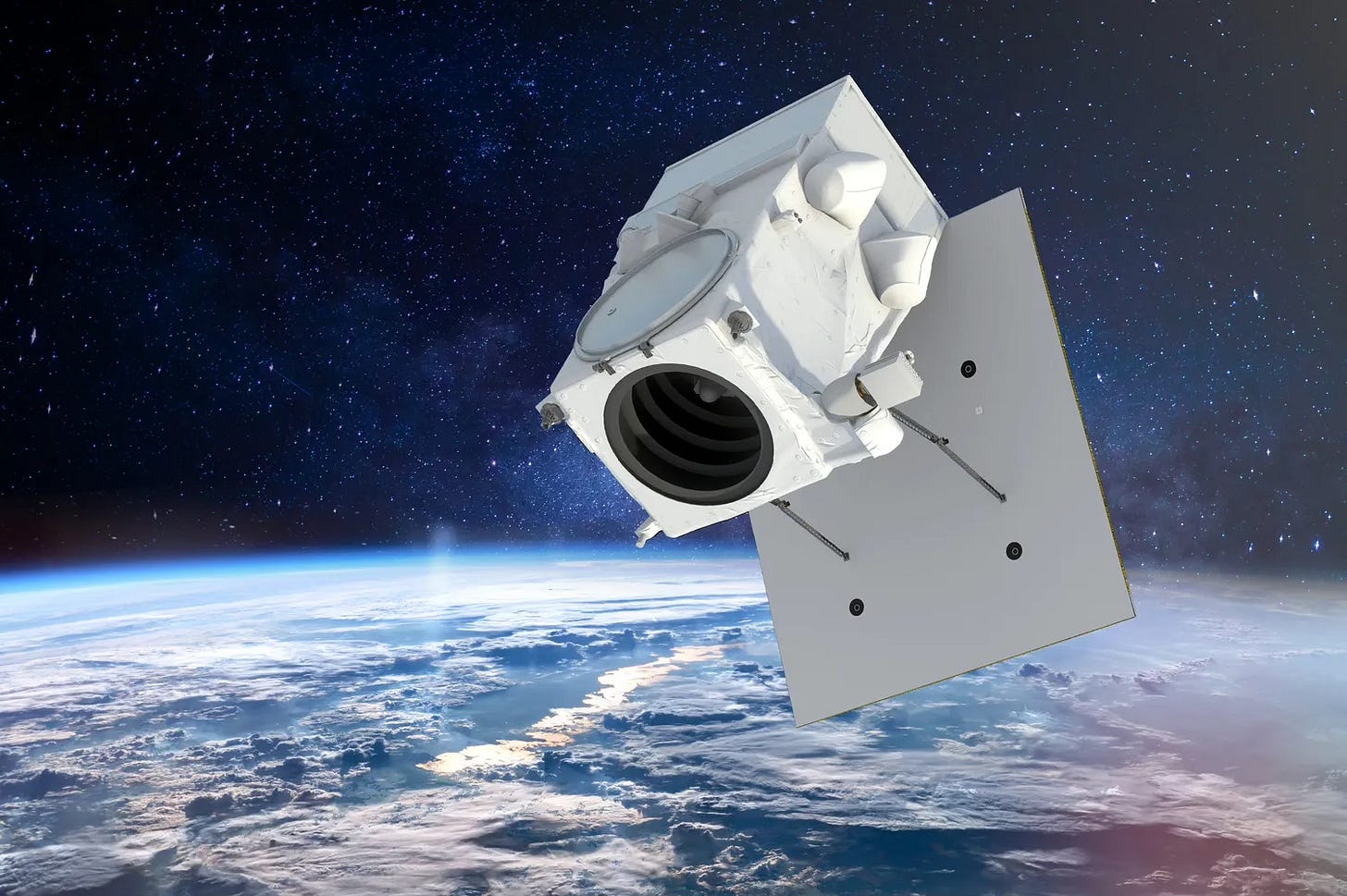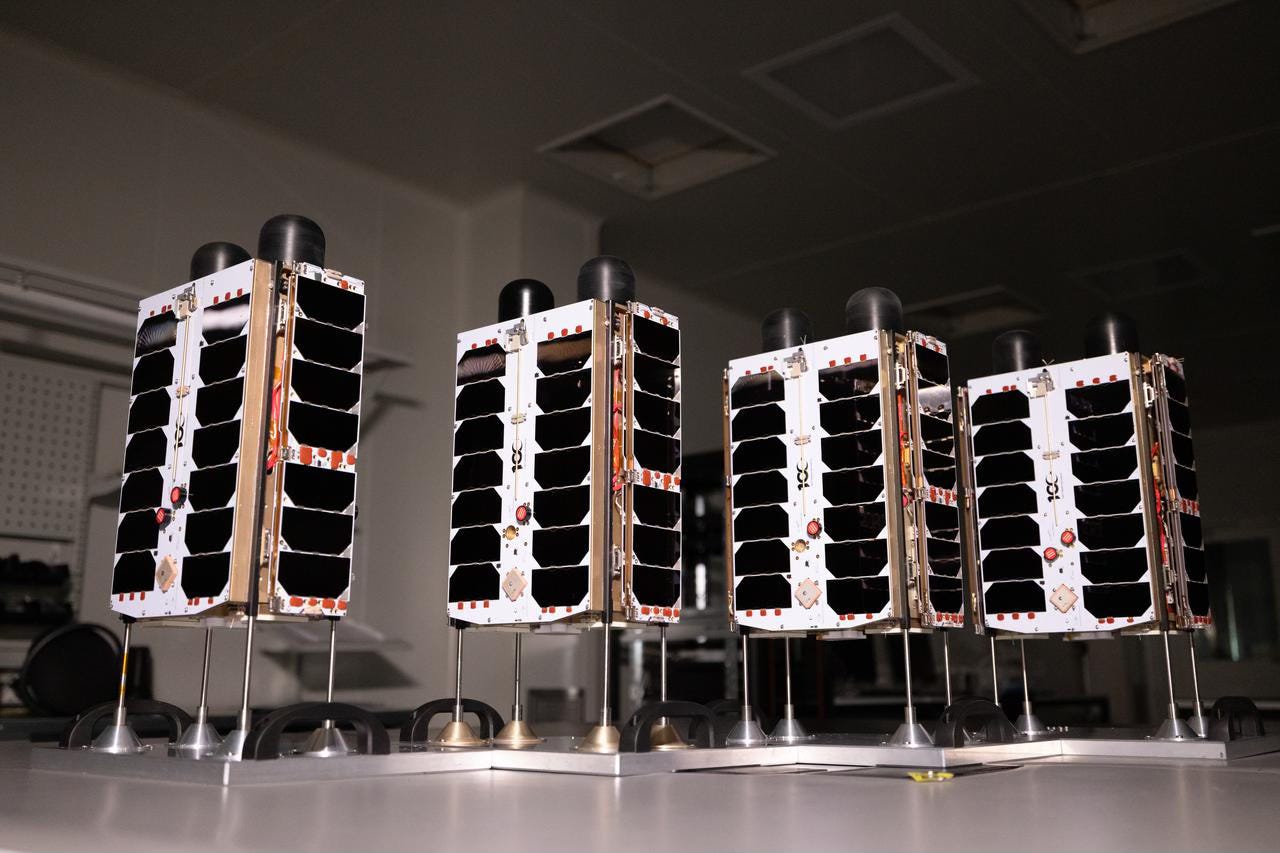Middle East Space Roundup: 23 to 29 June 2025
A summary of all the space news in the Greater Middle East over the past week, brought to you by AzurX


The following are the major space developments in the Greater Middle East region tracked by Middle East Space Monitor over the past week:
Iran-Israel Conflict: The Counterspace Angle
Space Denial: Israel Strikes Satellite Infrastructure in Iran
In its latest round of airstrikes before the ceasefire, the Israeli Air Force targeted Iranian military satellite infrastructure, radar stations, and air defense systems in western Iran and Tehran, as part of ongoing efforts to degrade Iran’s reconnaissance and missile capabilities. According to the IDF, the strikes focused on facilities linked to missile storage and launch, as well as military satellites used for Iranian surveillance operations in Kermanshah and Hamedan. This escalation follows earlier Israeli and U.S. attacks on Iran’s nuclear and military sites amid rising regional tensions.
Cyber Threats: Pro-Palestinian Hackers Attack Israel’s Space Infrastructure
Pro-Palestinian hacktivist group GhostSec has intensified its cyber operations against Israel’s space assets, shifting focus to ground-based satellite communication infrastructure such as very small aperture terminals (VSAT) used by the Israeli military. Using open-source intelligence (OSINT) tools like Shodan and SNMP enumeration, the group has disabled multiple Israeli VSAT systems, causing service outages and raising concerns about the vulnerability of satellite-linked networks during conflicts. GhostSec's approach—marked by precise, ideologically driven attacks and strategic psychological framing—echoes past cyber disruptions to space infrastructure, including the 2022 Viasat KA-SAT hack, underscoring growing cyber threats to national space systems during geopolitical crises.
Report: Israel May Have New GPS Spoofing Method Against Iran’s Ballistic Missiles
A potential new form of global navigation satellite systems (GNSS) spoofing may have diverted Iranian missiles into the Mediterranean during the recent Iran-Israel conflict, according to analysis by Zephyr.xys, a U.S. location technology firm. Unlike traditional spoofing, which produces sudden GPS jumps, this incident showed a continuous, curved trajectory—suggesting a sophisticated technique designed to mimic missile flight paths and deceive guidance systems mid-flight. The development highlights the growing role of electronic warfare in space-enabled navigation systems, with spillover risks for civilian maritime and aviation safety, particularly in contested regions like the Strait of Hormuz.

Iran Suspected of Jamming & Spoofing GNSS Signals in Strait of Hormuz
Shipping through the Strait of Hormuz faced heightened congestion and persistent electronic interference—particularly affecting satellite-based navigation systems—amid escalating tensions following U.S. and Israeli airstrikes on Iranian nuclear sites. The Joint Maritime Information Center (JMIC) reports ongoing global navigation satellite systems (GNSS) disruptions likely originating from Bandar Abbas and the Central Arabian Gulf, raising concerns over Iran's potential retaliation, including a threatened closure of the strait. Industry analysts warn that any serious disruption to this critical chokepoint—through electronic warfare or physical blockade—would severely impact global oil and LNG flows, drive up maritime insurance costs, and trigger significant geopolitical and economic consequences.
Report: Bahrain and Qatar Caught Up in Regional GNSS Jamming & Spoofing
A sudden GPS disruption swept across Bahrain and Qatar on 22 June 2025, leaving thousands of users with location errors that placed them in Iran, while nearly 1,000 ships in the Strait of Hormuz reported navigation failures. Satellite analysts and maritime reports attribute the widespread jamming and spoofing to heightened electronic interference linked to escalating Gulf tensions following U.S. strikes on Iran. The incident highlights growing vulnerabilities in satellite-based navigation systems across critical Gulf infrastructure, raising serious safety and operational concerns for aviation, maritime, and digital services in the region.
Persian Gulf Jamming & Spoofing Has Major Economic Ramifications
Widespread Automatic Identification System (AIS) signal spoofing and GPS interference in the Strait of Hormuz and the Persian Gulf are now posing serious operational and safety risks for LNG tankers and other vessels, according to Independent Commodity Intelligence Services (ICIS) and UK Maritime Trade Operations (UKMTO) reports. Recent disruptions have falsely placed LNG carriers inside Iranian territory, forcing analysts to manually correct tracking data. The interference, escalating since May 2025 and intensifying after recent Iran-Israel hostilities, has already coincided with at least one serious collision near Fujairah. QatarEnergy had reportedly delayed Gulf entries for its LNG fleet, while insurers and operators reassessed risk exposure amid growing concern over maritime situational awareness and satellite navigation reliability.
Iran’s Ballistic Missile Program Intertwined With National Space Efforts
Iran’s ballistic missile program, now the largest in the Middle East, has evolved from imported Scuds to a sophisticated mix of short- and medium-range missiles with both liquid and solid fuel technologies. Critically, Iran’s space program is deeply intertwined with this military infrastructure, with satellite launch vehicles like the Safir and Simorgh derived directly from ballistic missile technology. While Iran claims its space efforts are peaceful, Western intelligence warns that advancements in satellite launch capabilities shorten the pathway to intercontinental missile development. The dual-use nature of Iran’s space and missile programs continues to raise regional and global security concerns.
Opinion: Elon Musk and Starlink in Iran - So Much Geopolitical Power in One Man’s Hands
Elon Musk’s 14 June 2025 activation of Starlink over Iran, announced with the terse message “The beams are on,” has injected a powerful new variable into Middle East geopolitics, according to Dr. Joscha Abels of the University of Tübingen, Germany, writing in The Conversation. Amid Iran’s sweeping internet blackout following Israeli airstrikes, Starlink’s satellite network offers Iranian citizens and protesters a rare means to bypass state censorship. However, as seen in Ukraine, where Musk unilaterally restricted Starlink’s battlefield use, this development raises serious concerns over the geopolitical power concentrated in private hands. Iran’s civil communications now depend on the decisions of a single billionaire, with little oversight or accountability.
Iran’s Government Declares Starlink SATCOM Terminals to be Illegal
Iran’s government has declared Starlink terminals illegal and threatened prosecution as thousands of smuggled units bypass a wartime internet blackout imposed after Israeli and U.S. strikes began on 13 June 2025. Despite Iran’s appeal to the International Telecommunication Union (ITU) for intervention, SpaceX’s Starlink continues broadcasting over the country, enabling encrypted videos of military strikes and anti-regime protests to evade Tehran’s cyber-censorship. Industry estimates suggest 20,000 clandestine Starlink dishes are now active in Iran, highlighting the growing geopolitical and information control challenges posed by satellite internet services in conflict zones.
The Role of Commercial Earth Observation Satellites in the Iran-Israel Conflict
Following recent U.S. airstrikes on Iran’s nuclear infrastructure, commercial Earth observation satellites from Maxar, Planet Labs, and Airbus played a central role in documenting damage and shaping global intelligence and media narratives. High-resolution imagery captured evidence of deep-penetrating MOP bomb craters at Natanz and missile base strikes in Kermanshah, while also revealing that key enrichment sites at Fordo remained untouched. The episode underscores the growing strategic influence of commercial satellite imagery—not just for governments but also for independent analysts, investors, and journalists monitoring military operations and geopolitical risks.
Report: U.S. Selectively Classifies Satellite Imagery of Iran to Shape Media Narrative
Following the U.S. airstrikes on Iranian nuclear sites, commercial satellite imagery from Maxar has fueled global open-source intelligence (OSINT)-driven media coverage, yet Washington has quietly restricted access to imagery of strategically sensitive areas like Jask, Bandar Abbas, and key Hormuz Strait islands since 13 June 2025, according to Intelligence Online. By leveraging sensor tasking priorities and distribution controls, the Pentagon has effectively limited commercial visibility over Iran’s maritime chokepoints while spotlighting selected nuclear target sites. This selective classification strategy shapes the global narrative while shielding critical Strait of Hormuz imagery from foreign governments, analysts, and media.
UAE Space Developments
Aspire Space and LEAP 71 Partner to Develop UAR-Based Space Launch Vehicle
Aspire Space and Dubai-based LEAP 71 have announced a strategic partnership to develop a large reusable launch vehicle capable of delivering up to 15 metric tons to low-Earth orbit (LEO), with Aspire relocating its operations to the UAE. LEAP 71 will design the propulsion system using its AI-driven Noyron platform, with hot-fire testing of the 200 kN second-stage engine set for 2026 and a maiden flight targeted for 2030. This collaboration positions the UAE as an emerging hub for advanced space launch capabilities, leveraging AI-powered engineering and regional space sector ambitions.
UAE’s Burjeel Holdings Sends Diabetes Experiment With Axiom Mission 4
In a landmark moment for the UAE’s space and health sectors, Abu Dhabi-based Burjeel Holdings and Axiom Space have launched the pioneering "Suite Ride" diabetes research initiative aboard the Axiom Mission 4 (Ax-4) to the ISS. The study, part of a wider UAE push into human spaceflight research, will test continuous glucose monitors and insulin stability in microgravity—addressing challenges that have historically excluded astronauts with insulin-dependent diabetes. The mission underscores the UAE’s growing role in space-based biomedical research, with potential healthcare benefits for millions in the MENA region and globally.
UAE’s Dubai Airshow 2025 to Feature Largest Ever Space Agenda
The Dubai Airshow 2025 will feature its largest-ever space program, with a dedicated Space Pavilion, two-day Space Conference, and extensive astronaut engagement, reflecting the UAE’s strategic push to position space as a core pillar of its aerospace and economic agenda. Led by the UAE Space Agency and involving key stakeholders like the Mohammed Bin Rashid Space Centre (MBRSC), FADA, the Technology Innovation Institute (TII), Airbus, and Thales, the event will showcase national space capabilities, foster international partnerships, and promote commercialization aligned with the UAE National Space Strategy 2030. The initiative underscores the UAE’s ambition to drive regional space sector growth, projected to reach $75 billion by 2032.
Morocco Space News

Morocco Assumes Chair of the 68th UN Committee on Peaceful Uses of Outer Space Session
Morocco has assumed the chairmanship of the 68th UN COPUOS session in Vienna, with Prof. Rafiq Akram, Director of Morocco’s Royal Centre for Remote Sensing, leading proceedings. Backed unanimously by the African Group, Morocco will steer discussions on space and sustainable development, climate change, water management, and the Space 2030 Agenda. The session also focuses on strengthening international cooperation for peaceful space uses and advancing Africa’s role in the global space sector, underscored by Morocco’s co-hosting of a side event on African space development with the UN Office for Outer Space Affairs.
Morocco Calls for Stronger Internal & Regional Space Cooperation for Developing Countries
At the 68th UN COPUOS session in Vienna, Morocco called for stronger international and regional cooperation to ensure space technologies benefit developing countries, highlighting its leadership through the African Space Agency and the Rabat-based African Regional Center for Space Science and Technology Education (CRASTE-LF). Ambassador Azzeddine Farhane emphasized Morocco’s national satellite program—featuring the Mohammed VI A and B Earth observation satellites—as a key tool for sustainable development, supporting sectors from agriculture to disaster management. Morocco also endorsed UNISPACE IV as a critical platform for addressing global space challenges and advancing African space capacity.
Egypt Space Developments

Egyptian Space Agency Hosts EU Delegation to Discuss Space Cooperation
The Egyptian Space Agency (EgSA) met with a high-level delegation from all 27 European Union (EU) missions in Cairo on 23 June 2025 to explore enhanced cooperation in space technology and scientific research. EgSA CEO Dr. Sherif Sedky emphasized Egypt’s growing role as a regional leader in space capabilities, highlighting the agency’s satellite design, manufacturing, and testing infrastructure. The discussions focused on strengthening Egypt-EU partnerships to support Egypt’s strategy of localizing space expertise and advancing joint research initiatives.
Chair of Egypt’s NARSS Touts Benefits of Satellite Data for Public Health
At Africa Health ExCon 2025 in Cairo, Islam Abul Magd, Chairman of Egypt’s National Authority for Remote Sensing and Space Sciences (NARSS), highlighted the critical role of satellite data in addressing public health challenges across Africa. Speaking at a workshop on developing CubeSats for healthcare applications, he emphasized how satellite technologies can enhance disease monitoring, air quality assessment, and telemedicine—especially in underserved regions. Abul Magd also underscored NARSS’s long-standing leadership in remote sensing and its commitment to capacity building and technology sharing across the continent.
Bahrain Space News
Bahrain’s Shaikha Hessa bint Ali Al Khalifa Becomes First Arab Muslim Woman to Chair COPUOS
Shaikha Hessa bint Ali Al Khalifa of the Bahrain Space Agency has been elected Second Vice-Chair of the UN Committee on the Peaceful Uses of Outer Space (COPUOS), becoming the first Arab Muslim woman to hold the position. Her appointment highlights Bahrain’s growing space diplomacy and follows milestones such as the launch of the locally designed Al Munther Earth observation satellite, progress on the CO₂Sat emissions-monitoring project, AI experiments in orbit, and participation in lunar and regional climate missions. Bahrain also reaffirmed its support for UN space sustainability and capacity-building initiatives.
Bahrain Space Agency’s CEO Participates in IAF Space Propulsion Workshop
Bahrain Space Agency CEO Dr. Mohammed Al Aseeri participated in the inaugural session of the International Astronautical Federation’s Technical Committee Seminar Series, focused on space propulsion technologies. Held under the IAF’s Workforce Development and Young Professionals Committee, the seminar gathered global experts to discuss advancements in electric and chemical propulsion, launch efficiency strategies, and international R&D initiatives. Dr. Al Aseeri emphasized Bahrain’s commitment to engaging with emerging space technologies and empowering young professionals to contribute to the sector’s future growth.
Other Regional Space Developments
Türkiye’s Plan-S Launches Four Additional Satellites for Its IoT Satellite Fleet
Turkish space technology company Plan-S has expanded its low-Earth orbit satellite fleet to 17 with the launch of four new satellites aboard SpaceX’s Transporter-14 mission. Focused on Internet of Things (IoT) communications, Earth observation, and remote sensing, Plan-S’s Connecta IoT Network now offers 40% faster data collection and gigabit-speed connectivity across key sectors like energy, agriculture, and logistics. Nearly all critical subsystems of the new satellites were domestically designed and built, marking a significant step toward Türkiye’s space technology independence. The company aims to deploy hundreds of satellites by 2030 to achieve global, uninterrupted IoT coverage.
Saudi Arabia’s Space Madak Sends Ten Student Experiments to the ISS
In a milestone for Saudi Arabia’s space education initiatives, ten student-designed experiments from the Space Madak competition were launched to the International Space Station as part of an international mission from Kennedy Space Center. Organized by the Saudi Space Agency in partnership with the Misk Foundation and Ilmi Center, the competition engaged over 80,000 students across the Arab world, fostering youth innovation in microgravity research. This initiative aligns with Saudi Vision 2030 goals to build a knowledge-based economy and strengthen the Kingdom’s participation in global space programs.
Lebanon’s President Aoun & Elon Musk Discuss Starlink for National Telecoms
Lebanese President Joseph Aoun held a phone call with Elon Musk to discuss potential Starlink and SpaceX involvement in Lebanon’s struggling telecom and internet sectors. Musk expressed strong interest in establishing a local presence, following earlier talks between Lebanese officials and Starlink’s global licensing team. With Lebanon ranking low in global internet speed metrics and constrained by fiscal and infrastructure challenges, Starlink’s entry could reshape the country’s connectivity landscape. The move follows Starlink’s recent regulatory approvals in Jordan, Oman, and Yemen, though its presence remains controversial in countries like Iran and Türkiye.
Qatar and Brazil Sign MoU to Cooperate on Radio & Satellite Spectrum Management
Qatar’s Communications Regulatory Authority (CRA) and Brazil’s National Telecommunications Agency (ANATEL) have signed an MoU to strengthen cooperation in radio spectrum management, with a focus on satellite-based monitoring and ICT development. Signed during the ITU Council 2025 meetings in Geneva, Switzerland, the agreement covers joint spectrum monitoring, training, and collaboration at international spectrum management forums. The partnership aims to enhance regulatory coordination, support human resource development, and foster innovation in response to evolving global telecommunications and satellite communication needs.
Be sure to catch up with space activities in the region in the next edition of Middle East Space Monitor’s space roundup!
Middle East Space Monitor is an official Media Partner of the Space Defense and Security Summit and World Space Business Week 2025, hosted by Novaspace in Paris










